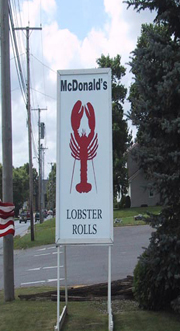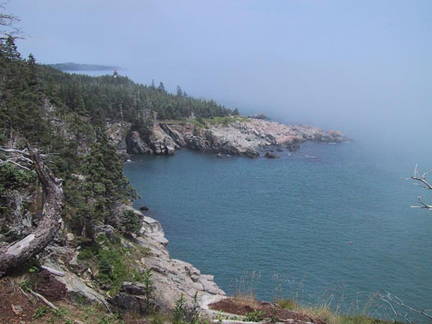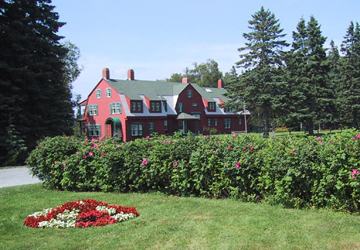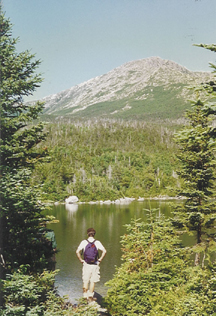Geotimes

Untitled Document

Travels in Geology
June 2005
Geology's Maine event
 As
you drive into the northeasternmost state in the union, you start seeing lobsters
everywhere. The king-sized crustaceans are harvested from the cold waters along
Maine's coast, and the state is justly proud of their high epicurean quality.
And in Maine, you don't have to be a gourmand to enjoy lobster; even McDonald's
serves up the delicacy. You will notice lobster images on signs, pamphlets and,
in particular, on the state's license plates. Beneath their lobster icon, the
tags proclaim Maine to be "Vacationland." For geologists as well as
lobster-lovers, nothing could be truer. Maine is a prime destination to revel
in geomorphic majesty.
As
you drive into the northeasternmost state in the union, you start seeing lobsters
everywhere. The king-sized crustaceans are harvested from the cold waters along
Maine's coast, and the state is justly proud of their high epicurean quality.
And in Maine, you don't have to be a gourmand to enjoy lobster; even McDonald's
serves up the delicacy. You will notice lobster images on signs, pamphlets and,
in particular, on the state's license plates. Beneath their lobster icon, the
tags proclaim Maine to be "Vacationland." For geologists as well as
lobster-lovers, nothing could be truer. Maine is a prime destination to revel
in geomorphic majesty.
A sign outside a McDonald's restaurant
in Houlton, Maine, advertises lobster rolls. Lobster is a delicious Maine specialty,
and quite common in the state. Photo by Callan Bentley.
Vacationland can keep you busy all summer. The cool climate and wealth of outdoor
activities (both in the woods and along the shore) offer more to do than anyone
could accomplish in a single visit. In the early part of the summer season,
head for the coast first. That way, you will avoid the worst of the black flies
in the state's interior.
 The
first place most people head for year-round is Acadia National
Park, located near Bar Harbor. The bulk of the park occupies the confusingly
named Mount Desert Island, a rocky outpost of pink granite, relentlessly sculpted
by both glaciers and the Atlantic's waves. Acadia hosts an excellent example
of a glacial erratic, a rock transported from somewhere else: Balance Rock,
an enormous boulder perched on the edge of an amazing view. Down at sea level,
Thunder Hole is a cave where deep rumbles boom outward whenever waves wash in.
The
first place most people head for year-round is Acadia National
Park, located near Bar Harbor. The bulk of the park occupies the confusingly
named Mount Desert Island, a rocky outpost of pink granite, relentlessly sculpted
by both glaciers and the Atlantic's waves. Acadia hosts an excellent example
of a glacial erratic, a rock transported from somewhere else: Balance Rock,
an enormous boulder perched on the edge of an amazing view. Down at sea level,
Thunder Hole is a cave where deep rumbles boom outward whenever waves wash in.
Quoddy Head State Park, near Lubec, Maine,
is the easternmost spot in the United States. It offers incredible coastal hiking
opportunities. Photo by Callan Bentley.
Promoters of Acadia tourism will also tell you that the summit of Cadillac
Mountain is the first spot in the United States where the dawn's sunrays hit.
This is only from October to early March. Most people, however, visit Maine
in the summer, not the winter. So if you want to be the first person in the
country to see the sunrise, you'll have to head farther north or east —
during the summer, Mars Hill, in the far northern reaches of the state (between
Presque Isle and Houlton), gets the sun first. And for an interim period in
between these two, for most of March, and most of September, Quoddy
Head State Park is the place to be.
Quoddy Head has the claim to fame of being the easternmost point in the United
States. Located near Lubec, Maine, on the border with New Brunswick, Canada,
Quoddy Head is a gorgeous seaside array of cliffs and forest, shrouded in fog
and capped with a squat, charming lighthouse. Hiking along its coastal trail
is an unqualified treat. Visitors experience the spectacular scenery, plenty
of moss and birds, and the occasional foghorn wail drifting in from the lobster
boats out in the bay.
 While
you are there, it's a short drive across the border (demarcated by the St. Croix
River) to go visit Campobello, the summer getaway of U.S.
President Franklin Delano Roosevelt. FDR's palatial family home is preserved
there in a unique international park run jointly by the U.S. and Canadian park
services. After you've toured the house, you can peruse the area's geology using
Donald Allen's (of Colby College) excellent pamphlet, "A
Geological Tour of the Roosevelt Campobello International Park."
While
you are there, it's a short drive across the border (demarcated by the St. Croix
River) to go visit Campobello, the summer getaway of U.S.
President Franklin Delano Roosevelt. FDR's palatial family home is preserved
there in a unique international park run jointly by the U.S. and Canadian park
services. After you've toured the house, you can peruse the area's geology using
Donald Allen's (of Colby College) excellent pamphlet, "A
Geological Tour of the Roosevelt Campobello International Park."
Campobello is Franklin
Delano Roosevelt's summer retreat, preserved as a unique international park
in New Brunswick, Canada, a short distance from the Maine border. Photo by Callan
Bentley.
Offshore, you'll find a legendary wonder: an authentic whirlpool. Midway between
Moose Island, Maine, and Deer Island, New Brunswick, lies a treacherous stretch
of water, Passamaquoddy Bay (location of the Disney film Pete's Dragon).
Passamaquoddy's tides are enormous, almost 30 feet. This is not surprising for
what is essentially an offshoot of the Bay of Fundy, where the tide ranges have
the world's record for the maximum vertical range between high and low tide.
As the tide comes into Passamaquoddy Bay, it brings 40 billion cubic feet of
water, which mixes with the St. Croix River's output. All this water flows in
turbulent eddies as it encounters a pair of submarine trenches and an undersea
mountain. At neap tides (the highest of the high), a funnel-shaped pattern develops.
Heavy winds accentuate the effect, and the result is the swirling whirlpool
known as the "Old Sow." The Old Sow can be a
dozen feet deep, and can develop in a matter of seconds. The whirlpool, one
of a handful around the globe, has claimed many ships and many lives. You can
see it from the shore, or you can charter a boat to go attempt a closer visit.
Just don't go too close!
 Finish
up your stay in Maine by heading into the woods. Fill up on gas and groceries
before you go, because the northern two-thirds of the state are in essence privately
owned wilderness. The area is known as North Maine Woods. Great rivers like
the Allagash and the St. John thread their way north through forested landscapes,
all owned by paper and timber companies. These companies maintain a sparse network
of dirt roads, and, thankfully, they do allow visitors. Moose and bears will
be more common companions here than other people. It is a truly wild place.
Opportunities for fishing, canoeing, kayaking and camping abound. Rigorously
qualified "Maine Guides" can be hired to lead excursions in the activity
your choice.
Finish
up your stay in Maine by heading into the woods. Fill up on gas and groceries
before you go, because the northern two-thirds of the state are in essence privately
owned wilderness. The area is known as North Maine Woods. Great rivers like
the Allagash and the St. John thread their way north through forested landscapes,
all owned by paper and timber companies. These companies maintain a sparse network
of dirt roads, and, thankfully, they do allow visitors. Moose and bears will
be more common companions here than other people. It is a truly wild place.
Opportunities for fishing, canoeing, kayaking and camping abound. Rigorously
qualified "Maine Guides" can be hired to lead excursions in the activity
your choice.
Located in Baxter State Park, Mountain
Katahdin looms above a hiker. The mountain's granite summit is the highest point
in Maine, and the northern end of the Appalachian Trail. Photo by Ronald Bentley.
In the middle of the North Maine Woods, a great mountain rises above the trees.
A chunk of granite 5,267 feet tall (the highest peak in the state), Mount Katahdin
is both the northern terminus of the Appalachian Trail and a terrific day's
climb. The mountain is situated in Baxter State Park, well
off the beaten track. In the words of former Maine Gov. Percival Baxter, who
donated the land for the park, it is "for those who love nature and are
willing to walk and make an effort to get close to nature." Don't expect
a mere drive through the park in Baxter. When you arrive, your car will be dusty
from the hundreds of miles of dirt road. Park it and set off on foot. Then you
can ascend the mountain itself, detouring around the glacial tarn that is Chimney
Pond, and summiting via a long arête appropriately called "The Knife
Edge."
Henry David Thoreau climbed Katahdin once and was terrified by the experience.
He knew the mountain by a more sinister spelling, "Ktaadn," and described
its summit as one of the "unfinished parts of the globe." While Thoreau
came away from Katahdin shaken to his core, it is more likely that modern visitors
will leave satisfied, tired, and with a healthy appetite. Time for some well-earned
lobster!
Callan Bentley
Geotimes contributing writer
Links:
Old
Sow Whirlpool stories
Campobello
Donald
Allen's Geological Tour of Campobello
Acadia
National Park
Quoddy
Head State Park
Bay
of Fundy tourism
Maine
Guides
Baxter
State Park
Rideout's
Lakeside Lodge (East Grand Lake)
Travels in Geology
Back to top
Untitled Document

 As
you drive into the northeasternmost state in the union, you start seeing lobsters
everywhere. The king-sized crustaceans are harvested from the cold waters along
Maine's coast, and the state is justly proud of their high epicurean quality.
And in Maine, you don't have to be a gourmand to enjoy lobster; even McDonald's
serves up the delicacy. You will notice lobster images on signs, pamphlets and,
in particular, on the state's license plates. Beneath their lobster icon, the
tags proclaim Maine to be "Vacationland." For geologists as well as
lobster-lovers, nothing could be truer. Maine is a prime destination to revel
in geomorphic majesty.
As
you drive into the northeasternmost state in the union, you start seeing lobsters
everywhere. The king-sized crustaceans are harvested from the cold waters along
Maine's coast, and the state is justly proud of their high epicurean quality.
And in Maine, you don't have to be a gourmand to enjoy lobster; even McDonald's
serves up the delicacy. You will notice lobster images on signs, pamphlets and,
in particular, on the state's license plates. Beneath their lobster icon, the
tags proclaim Maine to be "Vacationland." For geologists as well as
lobster-lovers, nothing could be truer. Maine is a prime destination to revel
in geomorphic majesty. 
 The
first place most people head for year-round is
The
first place most people head for year-round is  While
you are there, it's a short drive across the border (demarcated by the St. Croix
River) to go visit
While
you are there, it's a short drive across the border (demarcated by the St. Croix
River) to go visit  Finish
up your stay in Maine by heading into the woods. Fill up on gas and groceries
before you go, because the northern two-thirds of the state are in essence privately
owned wilderness. The area is known as North Maine Woods. Great rivers like
the Allagash and the St. John thread their way north through forested landscapes,
all owned by paper and timber companies. These companies maintain a sparse network
of dirt roads, and, thankfully, they do allow visitors. Moose and bears will
be more common companions here than other people. It is a truly wild place.
Opportunities for fishing, canoeing, kayaking and camping abound. Rigorously
qualified "Maine Guides" can be hired to lead excursions in the activity
your choice.
Finish
up your stay in Maine by heading into the woods. Fill up on gas and groceries
before you go, because the northern two-thirds of the state are in essence privately
owned wilderness. The area is known as North Maine Woods. Great rivers like
the Allagash and the St. John thread their way north through forested landscapes,
all owned by paper and timber companies. These companies maintain a sparse network
of dirt roads, and, thankfully, they do allow visitors. Moose and bears will
be more common companions here than other people. It is a truly wild place.
Opportunities for fishing, canoeing, kayaking and camping abound. Rigorously
qualified "Maine Guides" can be hired to lead excursions in the activity
your choice. 